-
Symbol Defintion
Example : Sqr(x) = Square root of x
AL 21 01. Polynomial Functions and equations
Diagram program
- Sketh Programs | Find graphic solutions.
- 01 01 y = a*x + b
- 01 02 y = a*x^2 + b*x + c
- 01 03 y = a*x^3 + b*x^2 + c*x + d
- 01 04 y = a*x^4 + b*x^3 + c*x^2 + d*x + e
- 01 05 y = a*x^5 + b*x^4 + c*x^3 + d*x^2 + e*x + f
- Start sketch programs
- Click Menu command
- Click polynomial functions in upper box
- Click y = a*x^2 + b*x + c in lower box
- Give coeffcient a, b, c : 1, -6, 8
- 01 11 Function highest Power is 7
- 01 13 Quartic equation
- 01 14 Quartic equation
- 01 45 Find F(u+v*i) of example 01 11
Go to Begin
Q02. Functions in factor forms
Diagram Programs
- Sketh Programs | Find graphic solutions.
- 02 06 y = (x-a)*(x-b)*(x-c)*(x-d) - e
- 02 38 y = (x-a)*(x-b)*(x-c)
- 02 39 y = (x-a)*(x-b)*(x-c)*(x-d)
- 02 40 y = (x-a)*(x-b)*(x-c)*(x-d)*(x-e)
- 02 41 y = (x-a)*(x-b)*(x-c)*(x-d) and y = e
- 02 40 y = (x-a)*(x-b)*(x-c)*(x-d)*(x-e) and y = f
- Start sketch programs
- Click Menu command
- Click Section 2 of functions in factor form in upper box
- Click program 38 y = (x-a)*(x-b)*(x-c) in lower box
- Give constants a, b, c : 1, 2, 3
- 02 09 Function highest Power is 7
- 02 10 Quartic equation
- 02 12 Quartic equation
Go to Begin
Q03. Rational functions
Diagram Programs
- Sketh Programs | Find graphic solutions.
- 03 07 y = 1/(a^x^2 + b*x + c)
- 03 08 y = 1/(a^x^3 + b*x^2 + c*x + d)
- 03 24 y = 1/x
- 03 30 y = ((x-1)^M)/(2*x)
- 03 31 y = ((x-1)^M)/(2*x)
- 03 47 y = x + 4/(x^2)
- Start sketch programs
- Click Menu command
- Click Section 3 of functions in rational function in upper box
- Click program 30 y = ((x-1)^3)/(2*x) in lower box
- Give power M as 3
- 03 24 y = 1/x
- 03 47 y = x + 4/x^2
- See rational function in graphic calculator : GC 03 10
-
GC
Graphic Calculator : Y = F(x)
- Example : Sketch y = x + 1/x
- Let y = (x^2 + 1)/x
- Use GC 03 08
- Give coeffcients : 0,1,0,1 0,0,1,0
- From graph we see that asymptotes : x = 0 and y = x.
- Example : Sketch y = x + 1/x
Go to Begin
Q04. Exponent and logarithm
Diagram Program
- Sketh Programs | Find graphic solutions.
- 04 15 y = sinh(x)
- 04 16 y = cosh(x)
- 04 17 y = tanh(x)
- 04 18 y = csch(x)
- 04 19 y = sech(x)
- 04 20 y = coth(x)
- 04 21 y = exp(x)
- 04 22 y = exp(-x)
- 04 23 y = ln(x) or log(x) base e
- 04 33 y = exp(x) and y = ln(x)
- 04 34 y = exp(x) and y = exp(-x)
- 04 44 Equation : e^x + e^(2*x) + e^y + e^(2*y) = 12
- Start sketch programs
- Click Menu command
- Click Section 4 of exponent and logarithm in upper box
- Click program 44 in lower box
- No data is required. Find asymptote from diagram.
- Reference : See Exponent in Algebra
- All programs are demo
- 1. Find intersections of y=exp(x) with its inverse
- 2. Find intersections of y=ln(x) with its inverse
- See PM 14 00
Go to Begin
Q05. Functions with absolute operation
Diagram program
- Sketh Programs | Find graphic solutions.
- 05 25 y = Abs(a*x + b)
- 05 26 y = a*Abs(x) + b
- 05 27 y = a*x^2 + b*Abs(x) + c
- 05 28 y = Abs(a*x^2 + b*x + c)
- 05 29 y = Abs(a*x^2 + b*Abs(x) + c)
- 05 46 Solve Abs(a*x^2 + b*Abs(x) + c) = d
- Start sketch programs
- Click Menu command
- Click Section 5 in upper box
- Click program 46 in lower box
- Give data a, b, c, d : 1, -6, 8, 0.5
- Reference : See Inverse in Algebra
- Click Menu and then click Demo
- Select section 5
- Select program
Go to Begin
Q06. Functions and its invsers
Diagram program
- Sketh Programs | Find graphic solutions.
- 06 32 y = a*x + b
- 06 33 y = a*x^2 + b*x + c
- 06 35 y = exp(x)
- 06 35 y = ln(x)
-
GC |
Graphic Calculator : y = F(x).
- Example 1 : None. See GC 06 01
- Example 2 : One.. See GC 06 02
- Example 3 : Two.. See GC 06 03
- Example 2 : four. See GC 06 04
Example : Find intersections of y = x^2 - 6*x + 8 with its inverse from graph
- Sketch program in GC 06 10
Go to Begin
Q07. Intersections of quadratic functions with other functions
Diagram program
- Sketh Programs | Find graphic solutions.
- 07 36 with y = 1/x
- 07 37 with y = p*x + q
-
GC |
Graphic Calculator : y = F(x).
- Example 1 : Two.... See GC 06 07
- Example 2 : One.... See GC 06 08
- Example 3 : Three.. See GC 06 09
Example : Find intersections of y = x^2 - 6*x + 8 with y = 1/x from graph
- Sketch program in GC 06 11
- Sketch program in GC 06 12
Go to Begin
Q08. Solve x^7+ 2*x^6- 5*x^5- 13*x^4- 13*x^3- 5*x^2+ 2*x+ 1 = 0
Method
- Equation | Mehtods
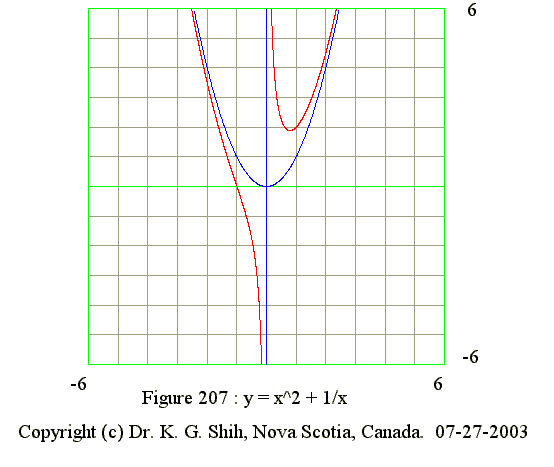
- 1. Estimate the real roots
- 2. Find the complex roots if we know real roots
Go to Begin
Q09. Diagram of y = (x-1)*(x-2)*(x-3)
Questions : Using the diagrams
- 1. Find domains if y is positive
- 2. Find domains if the curve is increasing
- 3. Find domains if the curve has maximum or minimum points

Go to Begin
Q10. Diagram of y = x + 1/x
Questions : Using the diagrams
- 1. Find domains if y is positive
- 2. Find domains if the curve is increasing
- 3. Find domains if the curve has maximum or minimum points
- 4. Find equations of asymptotes
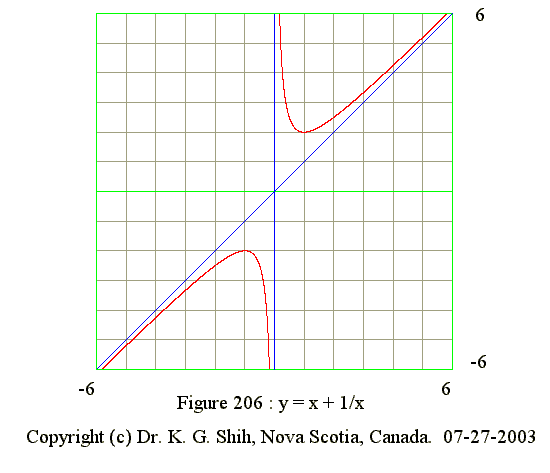
Go to Begin
Q11. Diagram of y = x^2 + 1/x
Questions : Using the diagrams
- 1. Find domains if y is positive
- 2. Find domains if the curve is increasing
- 3. Find domains if the curve has maximum or minimum points
- 4. Find equations of asymptotes

Go to Begin
Q12. Diagram of y = x^3 + 1/x
Questions : Using the diagrams
- 1. Find domains if y is positive
- 2. Find domains if the curve is increasing
- 3. Find domains if the curve has maximum or minimum points
- 4. Find equations of asymptotes

Go to Begin
Q13. Diagram of y = (x^3)/(x^2 - 1)
Questions : Using the diagrams
- 1. Find domains if y is positive
- 2. Find domains if the curve is increasing
- 3. Find domains if the curve has maximum or minimum points
- 4. Find equations of asymptotes
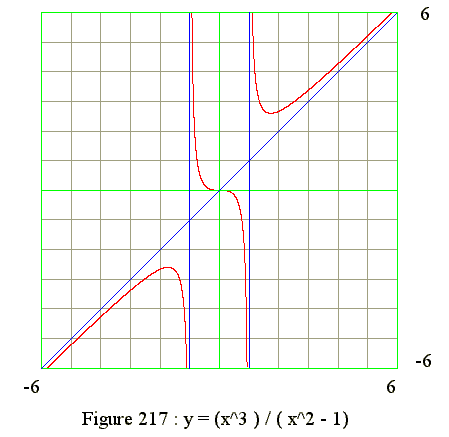
-
Graphic Calculator |
Section 3 and program 08.
- Note : Data are 1,0,0,0,0,1,0,-1
Go to Begin
Q14. Diagram of y = (x^4)/(x^2 - 1)
Questions : Using the diagrams
- 1. Find domains if y is positive
- 2. Find domains if the curve is increasing
- 3. Find domains if the curve has maximum or minimum points
- 4. Find equations of asymptotes

Go to Begin
Q15. Diagram of e^x + e^(2*x) + e^y + e^(2*y) = 12
Questions : Using the diagrams
- 1. Find domains if y is positive
- 2. Find domains if the curve is increasing
- 3. Find domains if the curve has maximum or minimum points
- 4. Find equations of asymptotes
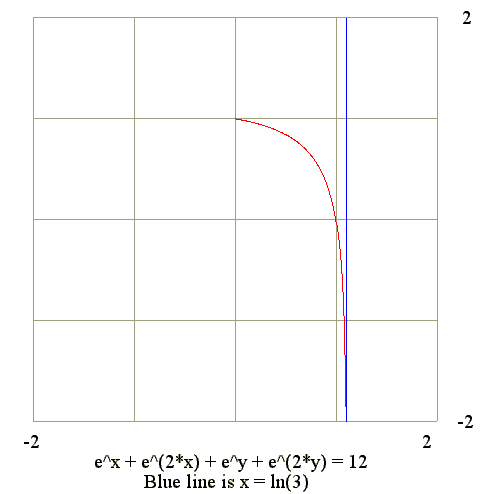
Go to Begin
Q16. Diagram of y = x^2 - 6*x + 8 and its inverse
Questions : Using the diagrams
- 1. Find domains if y is positive
- 2. Find domains if the curve is increasing
- 3. Find domains if the curve has maximum or minimum points
- 4. Find equations of asymptotes
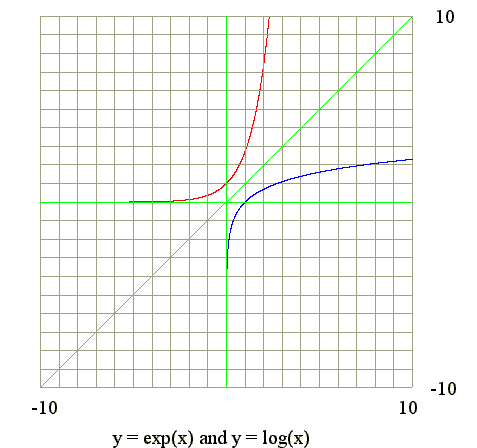
Go to Begin
Q17. Diagram of y = Abs(x^2 - 6*Abs(x) + 8)
Questions : Using the diagrams
- 1. Solve Abs(x^2 - 6*Abs(x) + 8) = 0.5
- 2. Solve Abs(x^2 - 6*Abs(x) + 8) = 1.0
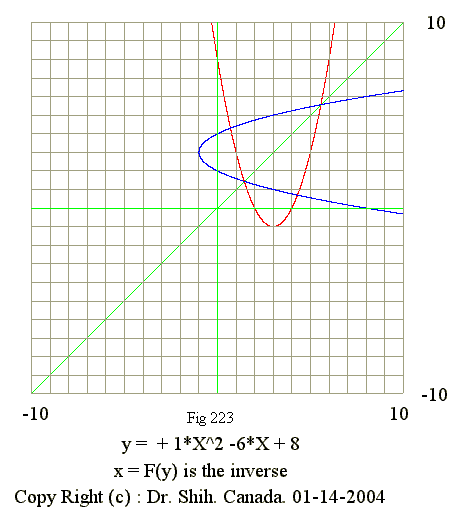
Go to Begin
Q18. Examples
Study notes of y = a*x^3 + b*x^2 + c*x + d
- 1. Cubic functions : Highest power is 3.
- 2. Slope of cubic function is y' = 3*a*x^2 + 2*b*x + c (a parabola).
- Curve is increasing if y' is positive.
- Curve is decreasing if y' is negative.
- Curve has critical point if y' = 0
- 3. Vertex
- It has none vetex.
- It has two vetices.
- 4. Concavity
- Concave upward upward if 2nd derivative is positive.
- Concave upward downward if 2nd derivative is negative.
- Point of inflexion if 2nd derivative is zero.
- 5. Zero values of y
- It has 3 zeros.
- It has 2 zeros (One duplicate real roots)
- It has 1 zero. (Two complex roots)
- 6. Cubic formula : It is used in MD2002 Lesson 17.
- 7. Example
- What is the expression of the demo function ?
- Polynomila form
- Factor form
- What is the y-intercept ?
- what are the zero values of y ?
- What are the coordinates of the critical points ?
- What is the domian for y on graph when y is less than zero ?
- What is the expression of the demo function ?
- 7. Exercises
- 1. Sketch y = x^3
- 2. Sketch y = x^3 -2*x^2 - x + 2
- 1. Slope of cubic function is y' = 4*a*x^3 + 3*b*x2 + c*x + d.
- Curve is increasing if y' is positive.
- Curve is decreasing if y' is negative.
- Curve has critical point if y' = 0
- 3. Vertex
- It has one or three vetices.
- 4. Concavity
- Concave upward upward if 2nd derivative is positive.
- Concave upward downward if 2nd derivative is negative.
- Point of inflexion if 2nd derivative is zero.
- 5. Zeros of y
- It has no zero of y. (Four complex roots).
- It has one zero of y. (One duplicate real and two complex).
- It has three zeros of y. (One duplicate real and two different real)
- It has four zeros of y. (Four different real roots)
- 6. Quartic formula :
- It used to find four complex roots
- It is used in MD2002 Lesson 17.
- What is the expression of the demo function ?
- Polynomila form
- Factor form
- What is the y-intercept ?
- what are the zero values of y ?
- What are the coordinates of the critical points ?
- What is the domian for y on graph when y is less than zero ?
- 1. Sketch y = x^4 + 4*x^3 + 6*x^2 + 4*x + 1
- 2. Sketch y = x^4 - 4*x^3 - x^2 + 16*x - 12
- 1. Slope of quaint function is y' = 5*a*x^4 + 4*b*x3 + 3c*x^2 + 2*d*x + e.
- Curve is increasing if y' is positive.
- Curve is decreasing if y' is negative.
- Curve has critical point if y' = 0
- 3. Vertex
- It has none, two or four vetices.
- 4. Concavity
- Concave upward upward if 2nd derivative is positive.
- Concave upward downward if 2nd derivative is negative.
- Point of inflexion if 2nd derivative is zero.
- 5. Zeros of y
- It has one zero of y. (One real root and Four complex roots).
- It has two zeros of y. (One real, One duplicate real and two complex).
- It has three zeros of y. (One duplicate real and one different real)
- It has four zeros of y. (Three different real and one duplicate)
- It has five zeros of y. (Five different real)
- 6. Quaint formula : It may not be availble in mathematic field.
- 7. Study the graph of demo question in Program 01 05
- What is the y-intercept ?
- what are the zero values of y ?
- What are the coordinates of the critical points ?
- What is the domian for y on graph when y is less than zero ?
- 8. Exercises
- 1. Change y = x^5 - 8*x^4 + 15*x^3 + 20*x^2 - 76*x + 48 to factor production
- 2. Above function have roots p,q,r,s,t. Find p*q*r*s*t (Production)
- 2. Above function have roots p,q,r,s,t. Find p+q+r+s+t (Sum)
Go to Begin
Q00. How to use sketch program
-
Sketh Programs |
Find graphic solutions.
- 1. Start sketch program
- Clcik sketch program
- Select run at current location
- Select yes to run
- 2. Sketch y = x^2 - 6*x + 8 which is in 01 02
- Click Menu command
- Click polynomial function in section 1 in upper box
- Click Program 02 in lowe box
- Give coefficients a, b, c : That is 1, -6, 8
- 3. How change scale and replot ?
- After we get the graph, we select new xmax and ymax in left box
- Click replot
- 4. What is demo command ?
- Click Menu then click Demo
- Select a section number
- Slect a program
- It will give a plot using default values.
- For example : What is the function of 01 04 ?
- 5. What is the meaning of 01 04 ?
- First number is the section number in upper box
- Second number is the function number in lower box
- 1. Start sketch program
- 1. Change to polynomial using program 38.
- 2. Method 2 : Use multiplication of polynomials.
- 3. Find y-intercept.
- 4. Quick sketch : Use 3 zeros and y-intercept to plot the curve.
- 1. Change to polynomial using program 39.
- 2. Method 2 : Use multiplication of polynomials.
- 3. Find y-intercept.
- 4. Quick sketch : Use 4 zeros and y-intercept to plot the curve.
- 1. Change to polynomial using program 40.
- 2. Method 2 : Use multiplication of polynomials.
- 3. Find y-intercept.
- 4. Quick sketch : Use 5 zeros and y-intercept to plot the curve.
-
Study Program |
Graphic Solutions of Polynomial Functions.
- Graphic method 1 : Sketch y = (x-a)*(x-b)*(x-c)*(x-d) - e
- Zeros of y are the solution (Program 06)
- What is the question ? What are the solutions
- Graphic method 2 : Sketch y = (x-a)*(x-b)*(x-c)*(x-d) and y = e
- Intersections of line and curve the solution (Program ??)
- What is the demo question ? What are the solutions ?
- Examples
- Program 09 : y = (x-5)*(x-7)*(x+4)*(x+6) - 504
- Program 10 : y = (x+9)*(x-3)*(x-7)*(x+5) - 385
- Program 12 : y = (28x-7)*(x-3)*(x+3)*(2*x+5) -91
- Program 13 : y = 12*x^4 - 56*x^3 +59*x^2 - 56*x + 12
- Program 14 : y = x^4 + x^3 - 4*x^2 + x + 1
- Graphic method 1 : Sketch y = (x-a)*(x-b)*(x-c)*(x-d) - e
Go to Begin
